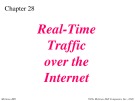
Multicast applications
-
Real-time Transport Protocol (RTP) is the protocol designed to handle real-time traffic on the Internet. RTP does not have a delivery mechanism (multicasting, port numbers, and so on); it must be used with UDP. RTP stands between UDP and the application program. The main contributions of RTP are timestamping, sequencing, and mixing facilities. This chapter provides knowledge of RTP and RTCP.
 29p
29p  tangtuy09
tangtuy09
 26-04-2016
26-04-2016
 55
55
 3
3
 Download
Download
-
Upon completion you will be able to: Differentiate between a unicast, multicast, and broadcast message; know the many applications of multicasting; understand multicast link state routing and MOSPF; understand multicast link state routing and DVMRP; understand the Core-Based Tree Protocol; understand the Protocol Independent Multicast Protocols; understand the MBONE concept.
 40p
40p  tangtuy09
tangtuy09
 26-04-2016
26-04-2016
 75
75
 5
5
 Download
Download
-
Multicast is UDP Based!!! Best Effort Delivery: Drops are to be expected. Multicast applications should not expect reliable delivery of data and should be designed accordingly. Reliable Multicast is still an area for much research. Expect to see more developments in this area. No Congestion Avoidance: Lack of TCP windowing and “flow-control” mechanisms can result in network congestion. If possible, Multicast applications should attempt to detect and avoid congestion conditions. Duplicates: Some multicast protocol mechanisms (e.g.
 55p
55p  danhson1409
danhson1409
 03-12-2010
03-12-2010
 83
83
 17
17
 Download
Download
-
Drops are to be expected. Multicast applications should not expect reliable delivery of data and should be designed accordingly. Reliable Multicast is still an area for much research. Expect to see more developments in this area.
 67p
67p  danhson1409
danhson1409
 02-12-2010
02-12-2010
 58
58
 8
8
 Download
Download
CHỦ ĐỀ BẠN MUỐN TÌM
















